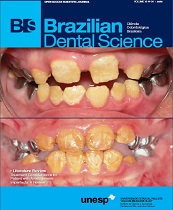Evaluation of tooth bleaching effectiveness through an experimental biological model at Gallus spp. eggshell
DOI:
https://doi.org/10.14295/bds.2013.v16i4.943Resumo
Tooth darkening compromised oral aesthetics andbleaching is a conservative and efficient method toreestablish it. The aim of this study was to assessthe action of 35% hydrogen peroxide in specimenspigmented with different substances. Twenty fragmentsobtained from chicken eggshell measuring 0.5 x 0.5 cmwere randomly divided into 5 groups (G1, G2, G3, G4and G5) with 4 specimens each. These were previouslyphotographed and pigmented respectively with coffee,cola-based soft drink, wine, beetroot and tobacco fora 48-hour period. In groups 1, 2 and 3, the specimenswere directly immersed respectively into the first threesubstances. In group 4, beetroot was mixed with waterto obtain a solution. In group 5, the specimens weresubmitted to tobacco smoke by the same period. Thegroups were again photographed and then submittedto bleaching with 35% hydrogen peroxide andphoto-activated by laser for 20 min. After the finalphotographs, the images were analyzed thorugh AdobePhotoshop CS5 software. It was observed that wine mostpigmented the specimens (33.34%), followed by coffee(10.35%), beetroot (9.56%), cola-based soft drink(8.85%) and tobacco (0.61%). The bleaching action wasmore effective on the specimens of G1 (93.9%) and G2(91.55%), followed by G3 (71.09%), G4 (62.74%) andG5 (57.38%). It was concluded that the methodologywas efficient in comparing the effectiveness of thebleaching agent on the pigments tested. The specimenspigmented with tobacco were those which exhibitedthe greater resistance to bleaching. Taking intoconsideration the use of this biological material, furtherstudies are necessary to simulate the effects of manyother substances onto tooth enamel.
Keywords
Bleaching; Discoloration; Hydrogen peroxide; Egg shell.
Downloads
Downloads
Publicado
Como Citar
Edição
Seção
Licença
TRANSFERÊNCIA DE DIREITOS AUTORAIS E DECLARAÇÃO DE RESPONSABILIDADE
Toda a propriedade de direitos autorais do artigo "____________________________________________________________________" é transferido do autor(es) para a CIÊNCIA ODONTOLÓGICA BRASILEIRA, no caso do trabalho ser publicado. O artigo não foi publicado em outro lugar e não foi submetido simultaneamente para publicação em outra revista.
Vimos por meio deste, atestar que trabalho é original e não apresenta dados manipulados, fraude ou plágio. Fizemos contribuição científica significativa para o estudo e estamos cientes dos dados apresentados e de acordo com a versão final do artigo. Assumimos total responsabilidade pelos aspectos éticos do estudo.
Este texto deve ser impresso e assinado por todos os autores. A versão digitalizada deverá ser apresentada como arquivo suplementar durante o processo de submissão.




























